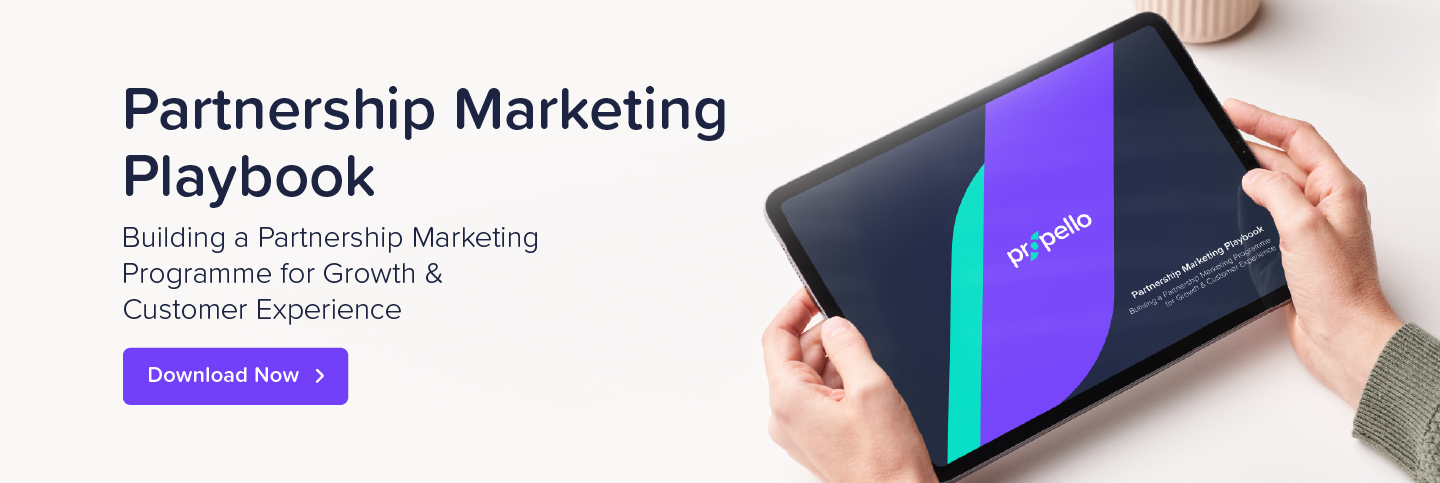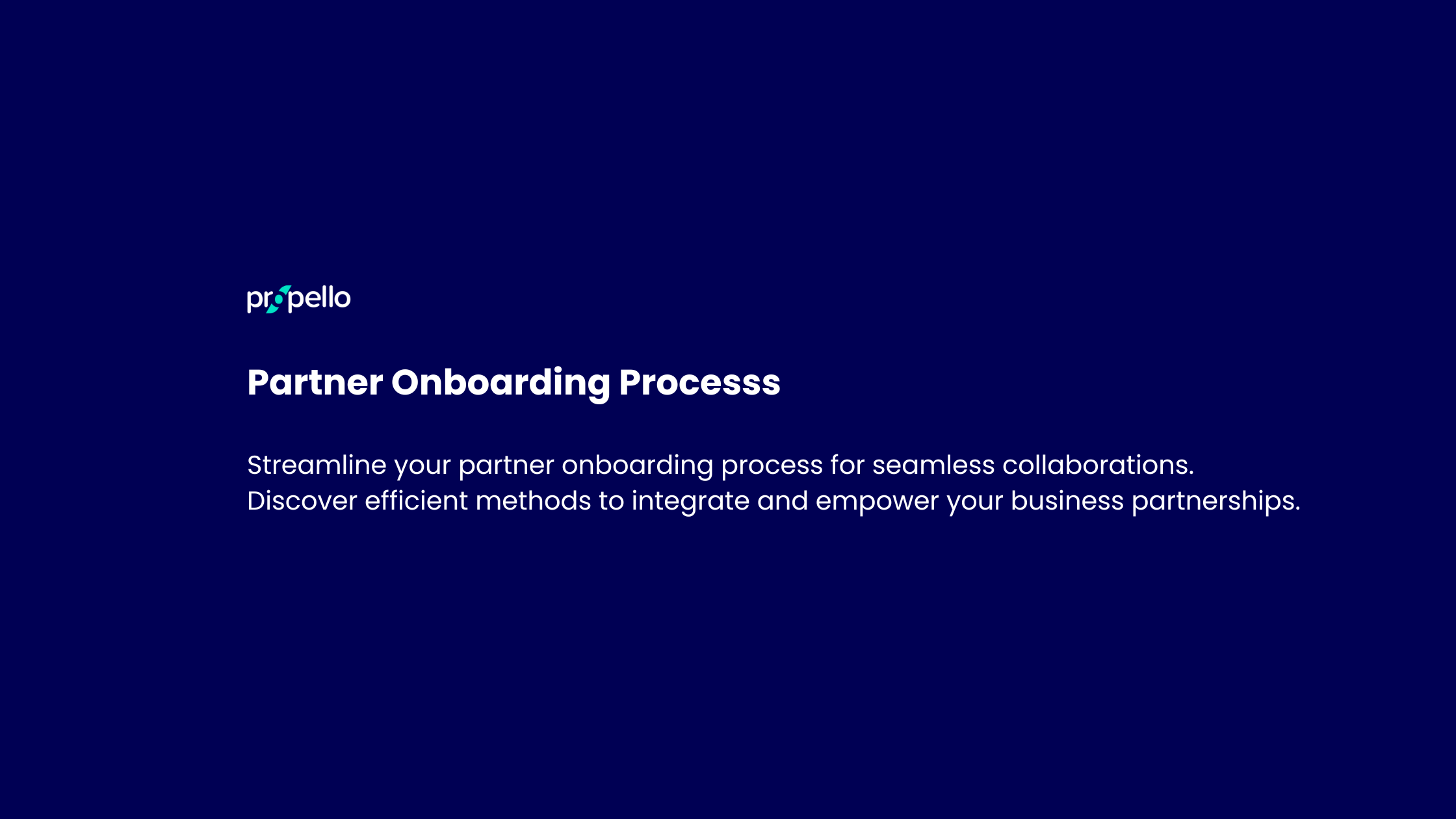The onboarding process is your partner’s first direct impression of your organisation. It sets the tone for partner relationships. Poor execution of partner onboarding can even affect your bottom line and the performance of future partnership opportunities.
Optimising the process for speed and efficiency should be your top priority.
Contents:
-
Why Should You Invest in Partner Onboarding?
-
It sets your partner up for success
-
It ensures compliance and governance
-
It helps you set operational standards
-
It helps you scale effectively
-
It helps you form stronger relationships
-
-
How Does the Partner Onboarding Process Work?
-
The welcome phase: welcoming your partners to the programme
-
The discovery phase
-
The documentation phase
-
The enablement phase
-
The feedback phase
-
-
How to evaluate the performance of your partner onboarding process
-
Partner Marketing Playbook: Streamline your partner onboarding process
A partnership marketing ecosystem that includes alliances with relevant brands that can offer added value to your audience is crucial for increasing competitiveness and driving customer loyalty and retention.
Brand partners facilitate access to markets where internal logistics alone would have difficulty establishing a firm footprint. This makes effective brand partner collaboration and a seamless partner onboarding process more crucial than ever.
Effective brand partnerships can provide real business benefits. By establishing mutually beneficial alliances, you increase the value of your business network and product or service.
Other benefits include:
-
Improvements to your service quality
-
Increased capability when selling your product to new audiences.
-
Cost reduction
-
Increased sales and marketing ROI.
Effective partner onboarding (also called vendor onboarding and channel partner onboarding) should be the foundation of your partnership ecosystem and a crucial element in your partner marketing strategy.
That’s because signing up your partners is the first step on your partnership journey. Partners usually become vital contributors to your business growth, and you must handle them with care.
This careful attention to detail is what makes your partnership valuable.
The issue is that the partnership onboarding process can be time-consuming. Yet, before the campaign launches, you must successfully onboard your partners into your programme. If your business has a sizeable number of partners, manually developing individual procedures to do that might be difficult.
Adopting a solid partner onboarding strategy, however, can help you reduce complexity and onboard your partners faster. Doing this will have a significant influence on your partnership marketing campaigns and brand identity.
A detailed plan is crucial to ease the transition phase for new partners. There are other partnership options on the market, so your onboarding strategy has to be robust and welcoming.
Back to top
What Does it Mean to Onboard Partners?
To introduce a new team member into your current corporate data ecosystem and establish a commercial connection with them as a brand partner, you must first acquire, validate, and consolidate the data and marketing materials required for such an alliance to function. This process is known as "partner onboarding."
When applied properly, it streamlines partner management and successfully conducts business activities with an organisation. To ensure timely cooperation and efficient management of the co-related activities and projects, both parties must develop an efficient communication strategy.
Building the ideal partner onboarding strategy
The ideal B2B partner onboarding process helps prevent unproductive alliances by ensuring that your partners meet your quality requirements. Establishing data governance, validation, and compliance processes helps to reduce the risks and challenges associated with partnership marketing programmes.
Onboarding starts immediately when your partners sign up with your brand. The process is an educational experience for your partners. It introduces them to your organisation and partner programme policies.
It covers a series of steps aimed at training partners, as well as referrals, resellers, and affiliate marketers, giving them the tools and skills to successfully promote your products.
This first impression should be a memorable one for all parties involved. If partners have a difficult time accessing your partner portal or find it difficult to understand your offerings, they might lose interest in the relationship.
Using automation via a robust digital platform like Propello can help smooth the onboarding process for your partners. It can also help you scale your programme quickly and effectively. Automation makes it easier to share resources and necessary information with your partners and manage your programme successfully.
Successful partner onboarding includes the following outcomes:
- Ability to scale the volume of partners and rewards into partner programmes
- Fast go-to-market partner programmes
- Engaged partners
- Longer partner duration
Back to top
Why Should You Invest in Partner Onboarding?
Channel partners have a significant influence on customer buying power. Regardless of the distribution channel you currently use, your partners can directly influence sales based on their knowledge of your products.
If your partner onboarding and training processes are lacking, you might lose valuable revenue from untapped markets.
Still having doubts?
Here's why developing a high quality strategy for partner onboarding is a good idea.
It sets your partner up for success
Arming your partners with the right tools and product information can enhance their customer communications and increase the chances of programme success.
It ensures compliance and governance
Partner onboarding makes sure that your partners are aware of all internal and external procedures and that they follow them. Using a digital platform eliminates the need for endless paperwork when onboarding new partners. You can run automated scans against external databases to easily confirm the partner's existence and legitimacy.
It helps you set operational standards
Partnership programme challenges are usually a result of poorly aligned brand guidelines and compliance issues. An effective partner onboarding strategy helps you create brand consistency and keep up with compliance throughout your relationship.
It helps you scale effectively
Properly onboarding channel partners can help your marketing team boost sales and drive growth for your business. The onboarding strategy speeds up the process of getting your products to the customer, offers real-time support, and highlights your UVP (unique value proposition).
It helps you form stronger relationships
Making a profit isn’t good for your bottom line alone; it also often translates to satisfied channel partners and satisfied customers. A winning strategy helps you form meaningful relationships with your partners by keeping them engaged, ultimately making them loyal to your brand.
Back to top
How Does the Partner Onboarding Process Work?
Partnership marketing takes a significant amount of time and resources to be successful. Putting a productive strategy in place is one extra step towards improving your chances of success.
Here are some tips to get you started with creating your onboarding strategy.
The welcome phase: welcoming your partners to the programme
As soon as a new partner joins your programme, follow up with them to maintain their initial motivation and encourage them to make their first sale or referral.
Inform your partners about the rewards system. Reiterating this information after enrollment is an effective strategy for keeping partners engaged. This is especially important if you have higher reward levels they can work towards.
The discovery phase
You and your partners work together on your existing processes and procedures during the discovery phase. You get a better understanding of the partner's assets, liabilities, and how onboarding might improve their ability to market your goods.
The documentation phase
During this phase, you provide your partner with the products and services they need to promote to their customer base. Best practices, sell sheets, support data, and marketing assets are a few examples of these crucial documents.
The enablement phase
At this stage, you start the enablement training, which involves introducing your channel partners to your business, offerings, brand, and ultimately your customers. Additionally, the training strengthens your value proposition and communications strategies, giving your partner the confidence to recommend your product over a rival's.
The feedback phase
Finally, creating communication channels and gathering feedback is a crucial step that will help you constantly improve your onboarding programme. It is the glue that holds together all the good work you put into making the programme a successful venture.
Back to top
Monitor Partner Engagement for the Best Results
Even if you meticulously set them up for success, it doesn't guarantee that your partners will perform perfectly every time. Monitoring new partners' engagement levels is a crucial step in any channel onboarding strategy.
For example:
- Are some partners avoiding the training activities? Then the effort to raise them might not be a worthwhile investment.
- Are they reading the materials attentively yet failing the corresponding tests? Then, even though they show willingness, they could use some more guidance.
Your regular reviews will be more effective if you have specific knowledge of the areas where your onboarding partners are excelling and failing, since you'll know the right questions to ask.
Monitoring engagement KPIs on a larger scale also allows you to correctly estimate your partner activation rate. These data patterns reveal the elements of your onboarding strategy that are the strongest and weakest.
How to evaluate the performance of your partner onboarding process
Once you've laid the groundwork for onboarding partners, it's critical to determine whether your partners understand the provided information and activities. The strengths and limitations of your programme can be highlighted by several KPIs, including those below.
Rate of partner activation
Despite the fact that there isn't a single benchmark that can be used to define "activation," this KPI represents the number of partners that will survive the onboarding process. Establish a clear definition of partner activation for your partnership programme, such as the first deal registration, the first sale, or the achievement of a specific income threshold.
A low activation rate may indicate that your onboarding is proving to be a barrier for new partners, which will directly affect this KPI.
Deal registration and closure rate
The effectiveness of your partner onboarding process is just one of several variables that affect the deal registration and closure rate for your programme. Partners may not be well-suited to promote your offerings and brand if they are unable to locate and convert prospects.
Key Takeaways
Partner onboarding in partnership marketing refers to the process of integrating and orienting new partners into a collaborative marketing programme. It involves providing the necessary information, resources, and support to enable partners to effectively engage with your marketing initiatives.
-
Why Should You Invest in Partner Onboarding?
-
It sets your partner up for success
-
It ensures compliance and governance
-
It helps you set operational standards
-
It helps you scale effectively
-
It helps you form stronger relationships
-
-
How Does the Partner Onboarding Process Work?
-
The welcome phase: welcoming your partners to the programme
-
The discovery phase
-
The documentation phase
-
The enablement phase
-
The feedback phase
-
-
Monitor Partner Engagement for the Best Results
-
How to evaluate the performance of your partner onboarding process
-
Measure the rate of partner activation
-
Measure the deal registration and closure rate
-
-
Partner Marketing Playbook: Streamline your partner onboarding process and scale your brand partnerships for business growth
Ready to supercharge your partnership marketing campaign?
Download our Partnership Marketing Playbook to learn how to onboard partners seamlessly and create an effective partnership marketing strategy. Overcome the barriers to launching a digital brand partnership programme and use this resource as a roadmap for growth.



.png)